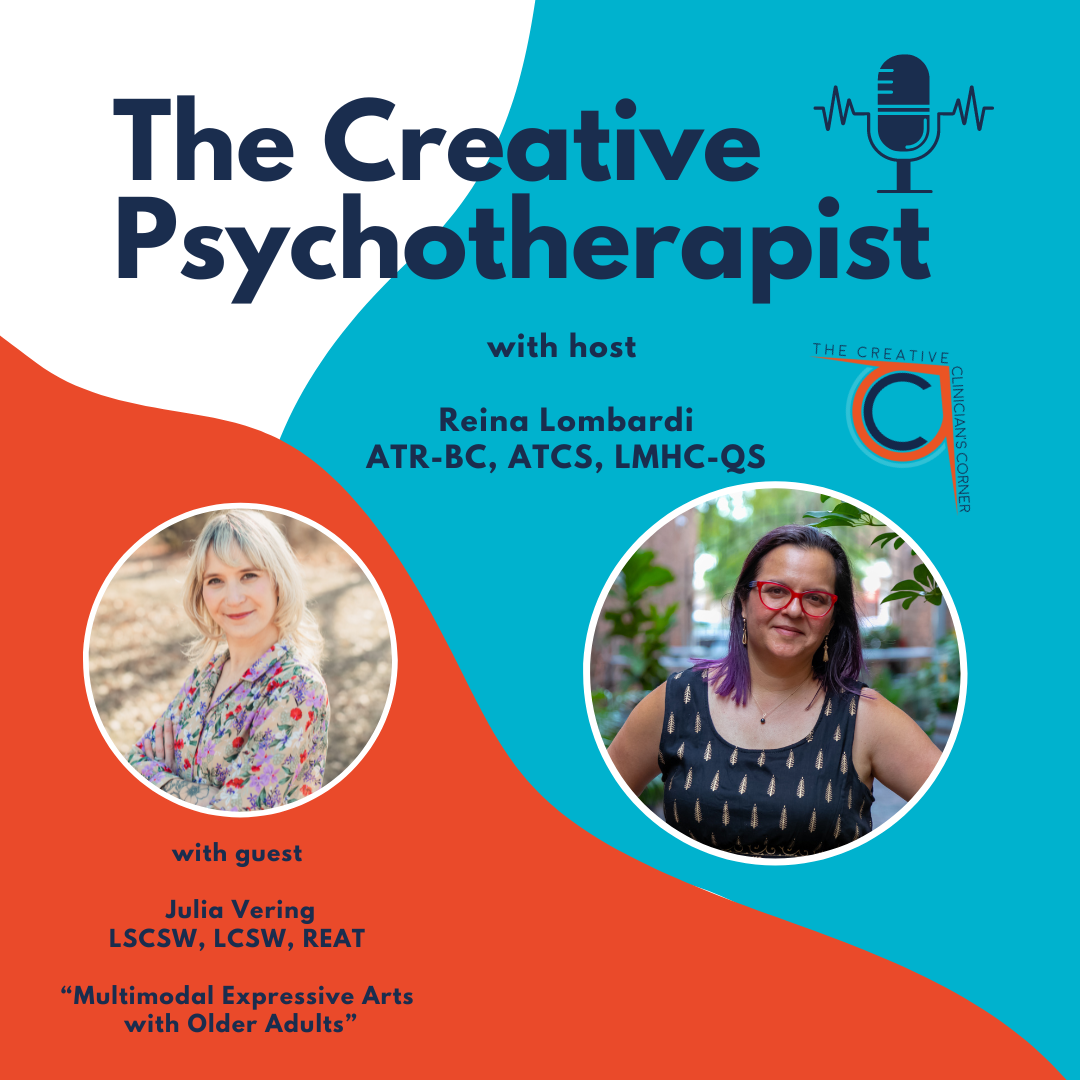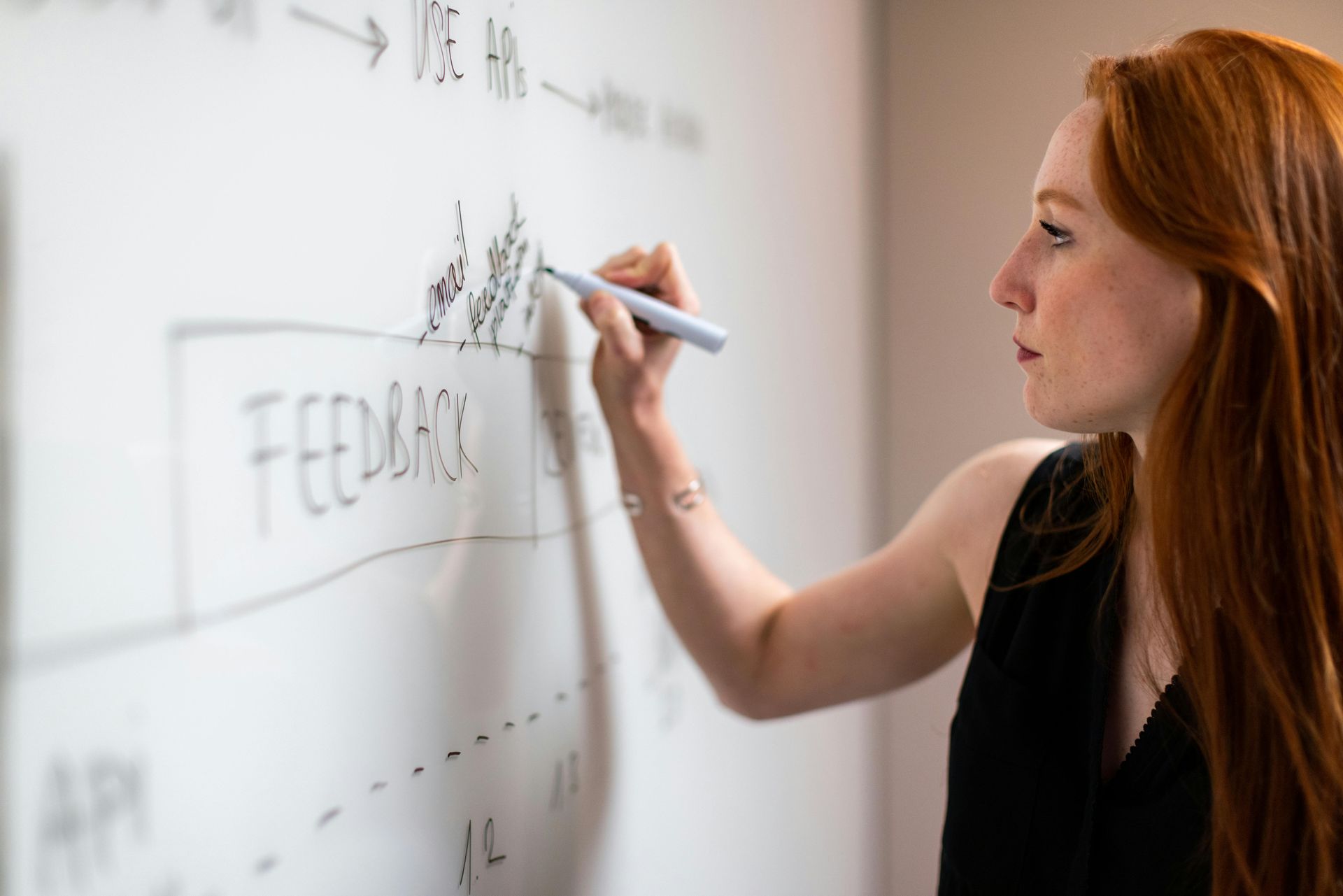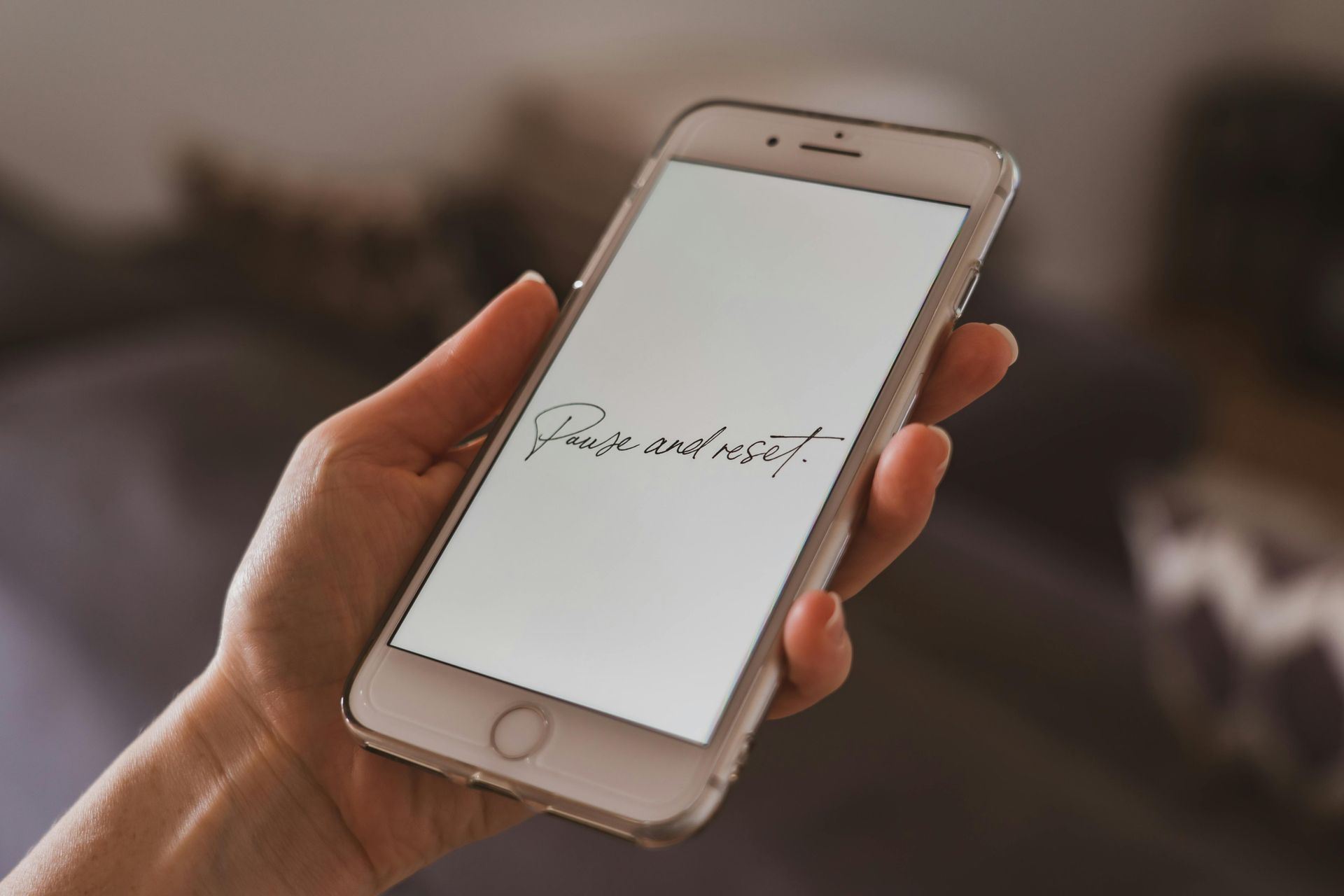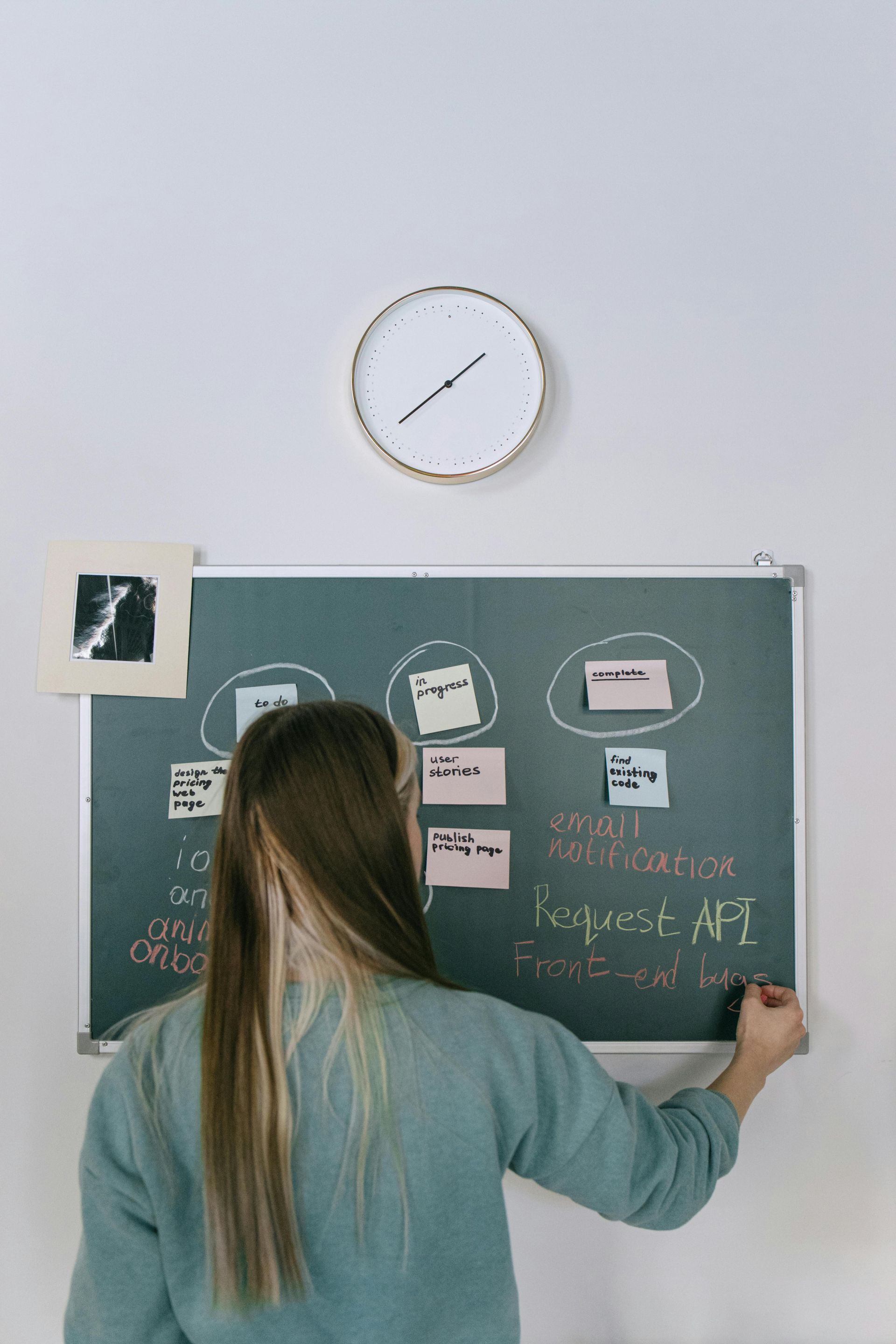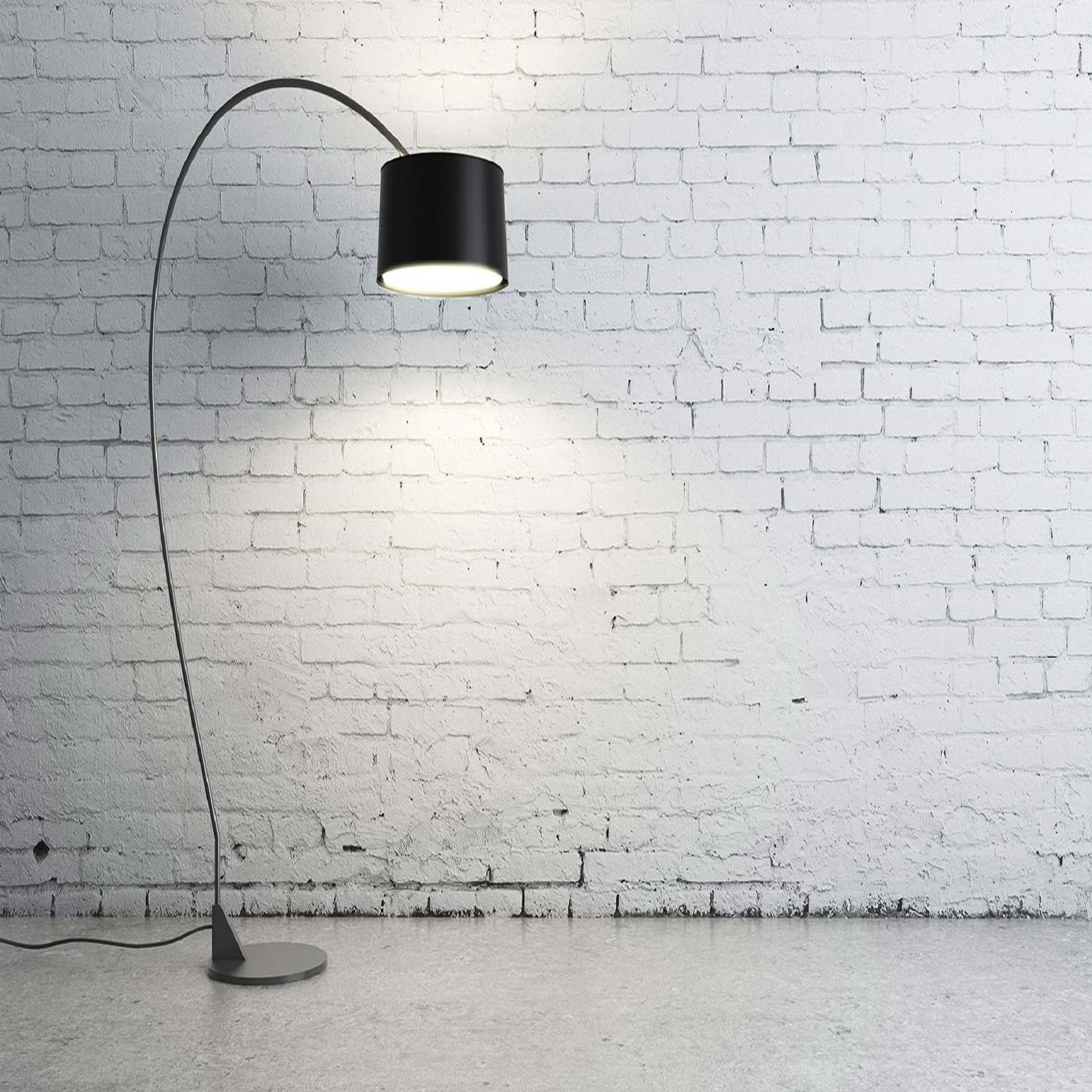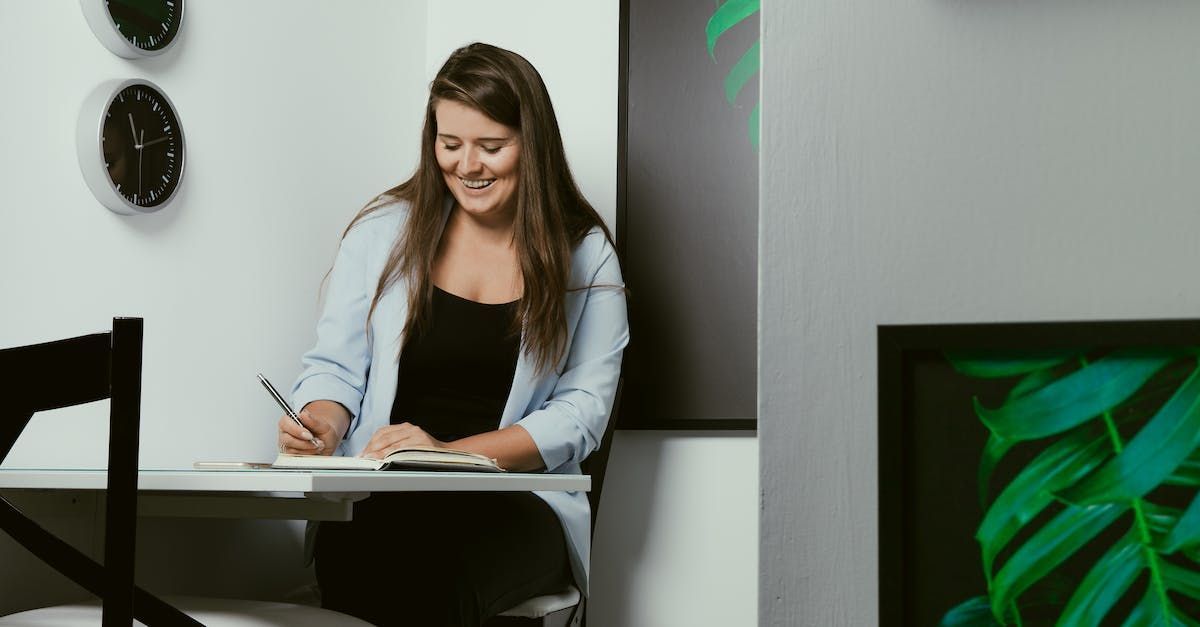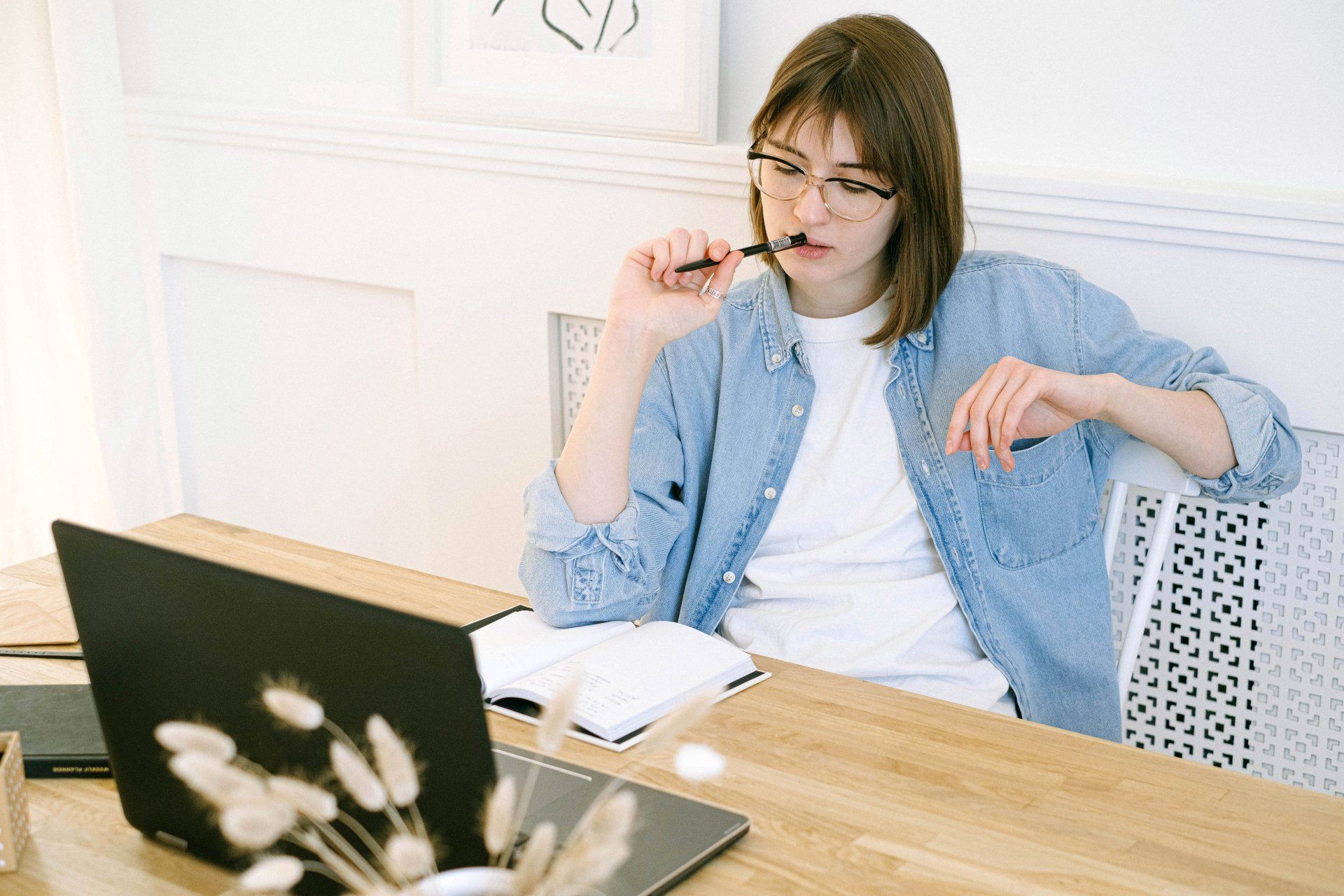Season 2 Episode 17 | Julia Vering | Multimodal Expressive Arts with Older Adults
FEATURED GUESTS: Julia Vering is a performance artist and musician, licensed clinical social worker and Registered Expressive Arts Therapist based in Kansas City. She has integrated the arts into social work for 20 years, centering her practice in joy, humor, imagination and the strengths perspective. Vering began experimenting with video-based drama therapy techniques while working at a nursing facility in 2004, and noticed that residents with dementia had decreased agitation, increased spontaneous communication and increased joy while engaged in this improvisation. Residents loved watching themselves in the “movies” they starred in. She continued to hone this method, incorporating fill-in-the-blank scripts, green screen technology and live performance participation via video projection. She has received grants from The Charlotte Street Foundation and Andy Warhol Foundation for Visual Arts for her community-based performance work involving collaborations with older adults and people with neurocognitive disorders. Vering tours and releases albums as “Unicorns in the Snow”, a performance art project that integrates interactive projections, stop-motion animation and original music. Vering has worked in hospice and long-term care settings for the last 17 years. She opened her private practice, Expressive Arts Therapy KC in 2022, serving children through seniors individually, pediatric palliative care patients in their homes, and groups in nursing facilities. Vering's expressive arts groups engage nursing facility residents in reimagining vintage movies and musicals through improvisational play. She became the first Registered Expressive Arts Therapist in the state of Kansas in 2023 and serves as the Kansas State coordinator for the International Expressive Arts Therapy Association. She integrates expressive arts, psychodrama and EMDR into her practice, and is currently creating a workbook and film on performance art interventions for people with neurocognitive disorders.
LISTEN & LEARN:
- Julia is the 1st Registered Expressive Art Therapist in Kansas.
- Learn how EMDR can be easily integrated into the expressive arts therapies.
- Methods of meaningfully engaging clients using interactive dramatic and videographic methods with older adults in memory care and hospice facilities.
- Julia's philosophy of "Try something new, there is space for you here," to engage clients at any level or ability.
RESOURCES MENTIONED ON THE SHOW:
- https://expressiveartstherapykc.com
- Sign up for Julia's updates on upcoming workshops and offerings.
- https://unicornsinthesnow.com
- Check out Unicorns in the Snow videos below:
- https://www.youtube.com/@juliavering2981/featured
SESSIONS AT THE SUMMIT:
- Friday November 17th, 2023 9:00AM-12:00PM Green Screen Video for Everyone: Multimodal Expression & Improvisation for Joy and Inclusion
- In this 3-hour virtual workshop, participants will have an opportunity to explore and experience the joys of incorporating video into clinical work with diverse populations. In particular, we'll highlight a conceptual framework along with the benefits of using creative video creation with older adults and people with neurocognitive disorders. Creative Generativity, which draws from the social work strengths perspective, role theory, narrative therapy, punk ethos, and embodied cognition will be at the core of our process. Learning will be highly experiential as we create our own collective movie-based improvisation as an example of an activity that can be used with virtually any population or setting. Absolutely no video or drama experience is necessary! The only technology you will need is a bright green piece of fabric or paper for a green screen (and ideally, a tripod with smartphone mount. See details below).
- Two inexpensive options for a small green screen Option 1 Option 2
- Optional, but helpful: Tripod with smartphone mount
Read the transcript below...
Hey there creatives. Thanks so much for your continued
listenership to the Creative Psychotherapist podcast. Today I am really excited to share. I know I'm always really excited to share, but
really no, I am. I'm excited to share this conversation that I had with expressive, registered expressive arts therapists and licensed clinical social worker Julia Vering and she's doing amazingly cool stuff with
video-based drama therapy techniques, screen screen technology in the work with hospice clients and adults with neurocognitive decline.
And I was just blown away and I hope you enjoy this conversation and are inspired
by the way she's making some changes to the way services are delivered
for those the aging population of people and yeah I was so inspired by this
conversation so without further ado.
Welcome! Now here's your host Raina Lombardi.
Thanks for listening to the Creative Psychotherapist podcast on your host
Raina Lombardi and I'm delighted to welcome my next guest, Julia Vering. She is a
performance artist and musician, a licensed clinical social worker and a
registered expressive arts therapist based in Kansas City. She's integrated arts
into social work for 20 years, centering her practice, enjoy, humor, imagination and the strengths perspective. Vering began experimenting with video-based drama therapy techniques while working at nursing a nursing facility in 2004 and noticed that residents with dementia had increased agitation, increased spontaneous communication and increased joy. I said increased agitation, really decreased agitation, which is what we're looking for.
Sorry about that, but they had increased joy while engaging in the improvisation. The residents loved watching themselves in the movies they starred in and she continued to hone this method, incorporating film the blank scripts, green screen technology and live performance participation via video projection. She's received grants from the Charlotte Street
Foundation and the Andy Warhol Foundation for Visual Arts for her community-based performance work involving collaborations with older adults and people with neuro-cognitive disorders.
Vering tours and releases albums as unicorns in the snow, a performance art project that
integrates interactive projections, stop-motion animation and original music.
She's worked in hospice in long-term care settings for the last 17 years and opened her
practice expressive arts therapy KC in 2022, serving children through seniors,
individually pediatric palliative care patients in their homes and groups in nursing facilities.
Her expressive arts groups engaged nursing facility residents in reimagining vintage movies
and musicals through improvisational play. She became the first registered expressive arts therapist
in the state of Kansas in 2023 and serves as the Kansas State Coordinator for the International
Expressive Arts Therapy Association. She integrates expressive arts, psychodrama and EMDR into her
practice and is currently creating a workbook and film on performance art interventions for people
with neuro-cognitive disorders. I'm so excited to talk with you today about your work.
Thank you for agreeing to do this. Thank you so much for having me and your work in getting all of us creative
people to know each other. Yeah, so I can't believe that you're the first registered expressive arts
therapist in Kansas. Yeah, this this year. Yeah, what's going on in Kansas? Oh, we need we need more
expressive arts therapists for sure. Yes. So, um, we have, I don't know how many art therapists
are music therapists we have around, but yeah, it's kind of the registered expressive arts therapist
credentials a little more of a baby compared to some of the older ones. I think it was born in the 90s.
So, yeah, I don't know. I guess I'm a Leslie grad. Oh, yeah. So, in my mind, I'm like, what?
That's impossible. 70s. How does not everybody know about this? Yeah. So, how did you get started
with like integrating drama and acting? Was that something that you were doing outside of being
a social worker? And just like that, let me check this out with my clients. Yeah, it started pretty
early because as a teenager, I knew I wanted to be a social worker and an artist and I thought
photographer at first. And essentially in college, I ended up doing an internship at a senior center.
And that's because I had worked with many different populations. I thought, oh, I haven't really worked
with seniors. I'll try it and fell in love and started doing, um, recording oral histories and
composing music to them. I switched from photography to video and music and got really into learning
about performance art in late 20th century. Composers and Lori Anderson and Miranda, got to see Miranda
July live, who's incredible. Um, Benny discipline artist filmmaker and everything else. Um, and so,
I started out as a performance artist myself. And then when I worked in my first job being a
activities assistant at a nursing facility out of college, um, I just thought, well, we've been doing
the same thing. I, you know, I looked at the calendar and I got hired. I thought they have to picture
around the calendar like every night for the last 10 years. Like I wonder if anyone else would want
to do something different since, yeah, after all. And also everyone's bored.
And there's only five people here. And so I thought, let's just do let's make a movie night.
And so I brought out the TV on the cart and I brought my ad. I have an extension collection of
extensive collection of wigs. And, um, I just thought, okay, I'm just going to bring some simple
improv scenarios. Unless you give it a world, we're going to video, we're going to just make the
movie and play it right away. No editing.
Just plug it into the TV on the cart. And I was bored late. I was bored by, I already knew the
residents, at least some of them pretty well and kind of knew what their baseline level of communication
was. And, and for some of them, it might be, you know, if I would ask them, what is your name,
it would be quite a delay. And maybe. And so with one of these residents at that kind of level,
I said, okay, you're going to a restaurant and you just realized you're in a date and you thought
you're well, and he was like, well, let me go out to the car. And I was just like, I just went on
and on and it was like, per made perfect sense. And then they brought in this other lady.
She was screaming and they, um, there's sometimes, you know, we get someone that's causing a wreckage.
And they're like, let's drop them off in activities. And so she was like, what am I to, you know, she was in a,
she had just moved in. She was like, they stole my apartment. What am I doing here? And for woman.
And so I said, okay, hold on. You can we just take a second here, your movie director.
And you just auditioned this woman and you have to tell her she didn't get the part. And I swear,
like that she was like, oh, honey, your hair is just all wrong. I was like, last. And she didn't go back
to screaming. And so and then I, you know, it was, this was an old camcorder. This is like not fancy.
I think I was in Burr, my dad's camcorder. I plugged in. I showed him the movie, you know, which had no
editing. And they were like, wow, the movie. And so I kind of thought sparked and inspired about
this full like, what is the future of video technology and performance art and like, what else is
here? And so at that level, you know, I was working a minimum wage job with a liberal arts degree.
The person, you know, I was the activities assistant, which people were like, why did you go to college
for this job? Like, are you crazy? And, you know, they said the next day when I came in after that first
time, my boss was like, everyone's talking about the movie thing, but we talked to the lawyers and you
can't do, you can't do video anymore. And so it kind of took, yeah. So it was like, okay, note to self,
get another degree. And so it took like six, you know, I did still play with a lot of drama and
improv. And let's do a puppet show and and do things that way.
But it was kind of like, okay, I've got to get a few more, I got to get another credential and and move
myself up in the ladder so that I can do this, do this kind of work the right way and get permission
and have enough, you know, credibility that I'm about the intention of this work that I can actually make it happen.
I'd such an awesome story. And I think, I mean, that's really the emergence of all of our expressive
arts disciplines, right? Somebody who has a deep connection with the art process brought it in a space
in a space where I think often humanity gets lost. Yeah. And the arts re-infuse that into the space.
And it really does wake people up in a different way. Absolutely. I talk about the dehumanization of
our healthcare system. And I'm sure you've heard people say, you know, I'd rather die than go to a
nursing facility. Yeah. And people aren't joking when they say that. And that's a problem. And I know
why they say that. Of course. But yes. And the reason I've, I mean, been able to continue to do this
work and kind of elevated and get degrees and things and now get, do it at a level that's sustainable
for me. And that's recognized is is my colleagues, my interdisciplinary colleagues, seeing the impact
of the arts on our health, patient and on the residents and vouching for it.
So are you a art? Obviously you're doing green screen technology. So you are using film now in your work.
Well, so let me say that until the pandemic I was doing, I was working for a day program for people
with early stage early, demon stage dementia. And in that program we had, so it was all green screen
video work. And so they would come in. We would start each session by watching the edited version of
what we had made the week before. And so again, people wouldn't really remember what,
necessarily what we had done. Just like it was fun, but I don't really remember which show we did or
what we did. And so being able to re-experience that joy while watching it. And then also kind of like,
well, where were we? Because it's like, oh, there's these cool backgrounds.
It's like, you know, we did foot loo. So it was like, I use the background from Save by the Bell.
So, so unfortunately the green screen work has not picked up again, but I am doing mostly nursing
facility work now without using video, although I am working on a film of to document the work and
hopefully get more people using intermodal expressive art with this population. And for people to
build off of it and play more, that's my goal. No, that's awesome. I have such respect for what you're doing.
I know it's hard to change systems. And those systems really have a very closed box. So to be able to open
it and get in there and start small and convince people like, this is worth investing in because it's
increasing these folks quality of life. And it's bringing them into the present moment where they can
live and engage in meaningful ways. That's so powerful. Absolutely. I mean, it's essential, right?
It's what makes life worth living. And not only that, you know, but identity expansion. Like there's
these old models where we kind of like stop developing at 60 and like, I'm particular.
That you can still have new experiences and expand and create new work at that age with those
conditions. It doesn't have to be doing all a single long to Frank Sinatra, although I will do that
at time. But let's make something new. Let's be frank. Let's see what Frank would do. Like let's not
just listen. Let's become it. Let's. Yeah. I think that there's something that happens in those settings
where there's there's a sensory deprivation. That occurs in a nursing facility. And if somebody's
never worked in a nursing facility and spent a lot of time there, they might not know. But even the
decor of the space, it's really, really unappealing. You know, the access to the locations, if you're
in a locked facility, you're kind of bouncing from one space to another, pacing a hallway.
And we need sensory interaction. Absolutely. Right. Of a variety of things, I think as functioning,
you know, adults out in the world where we're inside of our homes, we're outside of our homes,
we're in different environments. We are experiencing a constant flurry of sensory information,
which is important to our neural health. And then as soon as somebody is starting to experience
this decline, it seems like that's really important to be bringing in that they are still being
stimulated in these ways. And I can see how the work that you're doing, bringing in props and
and getting them to move and and watch themselves on the screen, like all of these things are really
contributing to that stimulation that they wouldn't be getting. Yeah. And the sense of community,
I had one of the residents, so I was the facility a couple of weeks ago, say like, hey, and she's
the resident council president. She's like, how often do we even know who each other are?
Like when we're not doing this group, we don't talk to each other, we don't know each other. Like so it's also
community building. And I, you know, when I started out as an activities assistance, it was like, well,
the people on hospice, they need one on one. So I would go, you know, revolution on their hands and
do do your abbie and all those things. But really, there's, I mean, there's some reasons that clinically
people need to our bedbound or something. But for the most part, not really. And so that same person
that would be stuck in a one on one, which means like more time in their room could come out and be
in my group. And even if they are nonverbal, quote, quote, quote, they can absolutely be a part in a play
and take care of the baby or be used the dog puppet or, you know, smile and mouth some words as I'm
putting the microphone to their lips. Like all of those things. But if we don't try, we're not,
we're going to find out. Yeah. So true. So so true. It's easy to just say, oh, that person, that person
is mute or not even give them the opportunity. I think that happens to with young people as well.
Right. Like, oh, well, you know, they stopped talking. So why are you asked, why are you inviting them to
speak? I hear that from the, you know, the teenagers I work with who are on palliative care services
about, yeah, the isolation and how they're treated, you know, as being like a wheelchair user. Like,
yeah, that it's, I mean, as if being a teenager wasn't isolating enough period and then to have that
and then the pressure, the same pressure to have the certain body and all those things, you know,
so yeah, there's, and we can't afford to do that, right? Like, there's going to be the 2040,
the number of one in five Americans is going to be over 65 by 2035. There's going to be more older
adults than kids. So we can't continue to let like working with people with disabilities or older
adults be kind of a fringe issue. Like in my master's level program for aging, you know, master's
social work, but aging, I think with their 10 people, like with the tiniest group, no one wants to study
aging, but it's so much fun and it can be new and creative and fun and there's so much there.
These, I mean, this work feeds my soul. Like, it's, there, there's a lot of people that are overlooked that
have so much to offer and we can't afford to just ignore that. Yeah, I, that, I know I've read that
statistic somewhere, but just hearing you say it, it's shocking. And what does that mean? Because
I feel like, well, that's going to be me. I'm going to be that aging person. And, you know,
are there, are there going to be people like you that are engaging us in meaningful engagement,
meaningful interaction for self and, and connection with others? Yeah, because our approach to just,
well, let's turn on the TV and everybody kind of gathers around the TV. It's so depressing.
Yeah, it is. I'd rather be in dirty dancing. We did last week.
I'd rather be pretending I'm Patrick Swayze. So yeah, then watching. Yeah.
Absolutely. So how, like, how do you go about building the relationships with the different
nursing facilities? And kind of I'm sure there's an education process that you go when you're saying,
okay, I'm going to partner with this facility to provide the service for them. Can you kind of walk
listeners who might be interested in doing something similar? Like, what is that process like?
And are there any suggestions for what they should prepare to present to the decision-makers in those
facilities? Yes, very good question. And I am very lucky right now in that. So before I started my
private practice, I was full-time employed by Kansas City Houses, like the oldest Houses in Kansas
City nonprofit. And I, as well, first as a social worker and then as an expressive therapist,
and started doing some groups in that role. And then so basically, once I decided I was going on my
own, I had a lot of support from my team that were like, we still need to do it. We still need
this expressive multimodal expressive arts work. Like, we are, this is the impact we see on our
patients faces. We see them come alive. And so they advocated.
So I turned that into, I have a contract with Kansas City Hospice and they fund and support the program.
And we already have relationships with the facility. And so, you know, actually one of the facilities
I was at this week, I used to work at, I worked at for three and a half years. So sometimes it's like,
I already know people and it's a small world. But, and so I just kind of put together a really simple one page piece of,
you know, very colorful and fun with all the different characters I play. But also like, hey, this is
what this program is. It increases joy. It increases communication, sense of community,
sense of meaning. These groups are completely inclusive of all levels and abilities.
And basically, these were the benefits for your residents. And at first they're like, what are you doing?
I was like, I still, I'm pretty honest. I could still work on my schedule a little bit. But,
I explained, you know, I've been doing this work a long time. I'm in a registered expressive arts
service. I love this population. This is my jam. And then it kind of builds like the first time I
might come to a facility, be like, what? And, you know, you get that, like you just said, you know,
well, that resident can't do that part or like, yeah, he can't really, that they can't do the thing.
And I just kind of politely smile and ignore this.
Go ahead and give them a role anyway. And sometimes it can be a role. That's the main role.
So we're not trying to like recreate this world of exclusion where we're like, okay,
and now that we have a small group, the people that aren't as verbal also don't get parts here.
Absolutely not the paradigm we're trying to recreate here. And so then once they see like
all the residents can do when they're like, what? Oh, you're going to perform. I'm like, no,
the residents in I are performing for each like with each other. They are playing parts like what?
And it takes my heart. And once they see what the residents can do and how they come alive and
then they, you know, the residents will talk to each other too. And then the groups will get bigger.
And people remember like, oh, I played this person last time and I did this. Oh, I want the drums again
or no, I want the baby. Don't I want that puppet? I want that puppet again. And like I had to,
you know, and it just grows and evolves. And it's like get to know each, you know, I'll learn each
resident a little bit and know like what they're strengths. Or I know that, okay, that woman is deaf.
And I had trouble at a group not too long ago, not trouble. That's not the right word. But I had
struggle connecting at time. I mean, with in a group where she, yeah, I was trying to use like
read my lips and write, anyway, we weren't we were struggling. And then last time I went in there,
I gave her the big puppet, this big huge puppet. And she was just like, oh, look at her dance,
look at her dance. And like all of a sudden she was in the group through the puppet, she was completely
in the group smiling looking at me, but also like, pausing at times when it was appropriate.
And completely engaged, even though she could not hear what was happening and didn't know that we were
necessarily doing dirty dancing. It didn't really matter. But she was completely engaged in her role.
And I had never seen her light up like that before. And I could just see watching
staff watch her. Oh, she's so powerful. So watch like, yeah, she, and then you know, anyway, it's so many
magical moments every time. I love it. So yeah, I guess, okay, my other, I didn't really answer your question.
The activity director is usually the person, you know, every facility is mandated. Like,
at least if there is skilled nursing facility to have activities and have an activity director,
which has some qualifications. So now whether or not they have one at the moment, that's another question.
But so there's systems already in place in all these places, some better than others.
And most of these places really need and want different things. I mean, more things. Like they,
you know, bingo only goes so far. So I think there's so much opportunity to, I would say also
you know, every facility has a social worker. So you could meet with the social work team because
they're the ones that are really monitoring the residents, you know, psychological mental health
issues through this mandated assessments. And all the screenings they need to do. So it's a win,
win for everybody that they can, you know, if you have a program you want to bring in like,
there, this is a, there's a lot of opportunities there. And if you get no, keep going. Because even if
you're offering, I hate to say that even if you're offering something that is not costing the
facility anything, many times you will still have to make many calls and track people down. It's not
the most well-oiled machine. So but don't despair. You will find like, there is going to be there's
tons of facilities. You'll find one. You'll get the right activity director on the phone that
hears what you're offering and can like, and knows the value. And it may not be every director.
And even if they don't know the value, it's okay. The residents know the value when you get in there.
Even if the activity person walks away and doesn't see the whole thing because I'm too busy.
The residents give you the feedback you need. Yeah, that's powerful. So connecting with the activities
director and the social work department and providing that with some education about how express
of our therapies can connect and wake in the lives of the residents so that they're engaged in their day.
Which I think facilities want to see that. Yes. In theory. No, they do. They do. They do. It's just
not always knowing how to do it. And I will say like on facilities behalf, I do not want to be saying anything.
But I mean, with especially, you know, facilities funded by Medicaid, which pays less than it requires
to take care of somebody. It is just not. It's a broken system. It's a really bad system. So
it's a really difficult system to work in. And there's a lot of equity issues with the way
certified nursing aids are paid and that the work, you know, they're doing back breaking work.
And the extra assistance typically don't get offered a lot of education on
will really, I'd say some facilities do a good job. Most probably don't do the greatest job.
So there's there's just real opportunity there. Yeah. And important. It's important work too.
I I living in Southwest Florida, there's an assisted living facility or skilled nursing facility
like every block everywhere you go, right? There's so many are aging population is large. And
and the need is there for sure. And I know that, you know, that's not just here. I mean, we have a
lot of retirees here, but it's right. I know the other stat was like, what is it? The number of adults
age 85 and older, the group most often needing help with personal care and the nursing facilities
will quadruple from 2000 to 2040. So the old old, they don't dare to tell us, there's like old, old,
and I can just call it like different types of old because you know, a 60 year old and a 90 year old,
that's a different generation that's not. So these these groups too, I mean, the people that live in
these facilities, it's a heterogeneous. This is not like, and depending on the facility too.
So I know, you know, for one facility, dirty dancing is going to work better than pajama game or whatever,
just based on the age, the demographics, all those things. Yeah. You must have a
excellent survey of like soundtracks in your mind for all of these different generations of people.
Yeah. And with, you know, technology, it's like, what do you want to hear? Like they can pick.
So yeah, if they, you could, if you want to do this song, you know, we'll go next. Yeah.
Oh, that's wonderful. Yeah. So I know you're out in the field doing the community work, but you also have
a practice. How do you balance that? How do you balance the two? Yeah, it's taken a minute to figure out.
But I, so I do the groups, the nursing facility groups working hospice one day a week, and then I do
private practice three days a week. And I've found that I can only see 12 to 15 max to feel okay and not
feel too stressed and feel sane. And like I have enough time to prepare and really think about everybody.
And then I kind of preserve up Fridays for like my own therapy work and peer, peer support. And
that's kind of how I've made my week work. And it so far it's working really well. And it really,
I kind of need both. Like I really like doing the individual work as well and integrating expressive
arts with EMDR and and using a lot of psychodrama and working with very different populations than I do
in the nursing facility. And I find I kind of, I really, I couldn't place it in an office more than
three days a week either. Like that would be a challenge for me. So having this balance right now kind of
feels kind of perfect for me, but it took a minute to figure out exactly where to put all the pieces and
all those things. So the spice is the variety of my life.
So I found that I don't think I could do private practice more than three days a week.
I didn't even know that going in, but I just got okay. So I got to yeah, contract with my
former employer one day a week. And then so I just, they worked out, but yeah, I know for
sure now I don't I know people do private practice five days a week and and people see like insane
amounts of clients. I just I know I can't I'm not that person. Yeah, that's okay. I agree. I'm not that person either.
Like my my case load is small. And I do a lot of like colleagues supervision. Right. Some supervision work.
I also do some contracted groups in the community.
And I agree. Like I like that movement. Right. It keeps it keeps it challenging. It keeps things
interesting. And it prevents that I love a routine. But having that routine day in day out, if it
gets boring, then oh, that's not good for me. Yeah. Yeah. It's not good. It's not good for you.
Yeah. No. Right. I think that there's something about, you know, being a creative person that
we are drawn to a lot of diversity in what we're doing. Yeah. To sit and do like
office work all day every day. That would be way too hard.
Yeah. I also try to throw in a little bit of my own work now. I kind of my own, you know,
performance art, art work, personal process. And sometimes that's collaborative at other times.
It's not. And working on our starting a new performance art project. My sister just gave me back
this amazing Barbie apartment. It's like this little cute thing that folds out and it's got like
a the murpy bed that folds down. So anyway, I'm playing around with some stop motion animation and
floor projections. It's going to be called the worm.
And it's going to be in a multi multi-dimensional projection kind of I do all this work with like hand to
mimeing with projections moving and making things bigger and smaller. And yeah, creating a surreal kind of experience through different modalities. Sounds incredible. Yeah. So it's important to have that time for you too.
As just being a performer and helping others perform, that's a tremendous energy output.
That, you know, if you're just sitting and engaging one on one, there's energy output. But when you're
orchestrating a whole group and and you're performing in that, that it's a whole performance in itself,
what you're doing, that definitely takes a lot and it makes sense that you.
Yeah, I couldn't do it more than one day a week actually the way I do it right now because you're
right of the physical energy. And also I have already thought about adaptations as a good older,
but I, you know, like right now I'm always most of my group is in wheelchairs and I'm walking around,
but I'm also like squatting a lot and kneeling and I'm always it's like I'm engaging each one one
on one and the group and kind of going back and forth and checking in with people and going back
and forth. So it's I am always drenched in sweat at the end. Plus I'm usually wearing a wig and
polyester costume. Yeah. It is physically physical. Yeah.
So it's nice to have like that really fit not that it's not also emotional, everything else, but doing
that is very different than sitting and doing EMDR with, you know, complex trauma. It's just it's
nice to be able to move back and forth. Yeah, for sure. I love the EMDR process so much. And I only
recently took the training to start doing it earlier this year, but I feel like I'm just going down
a rabbit hole in just learning as much as I can. And there's so much to learn and there's so many ways
of adapting it with the creative process.
So many with like using guitar for bilaterals, and you're like, fuck, fuck, drums, you know, just yeah, doing an inner weave with a little bit of a chi move. I yeah, there's so many actually I would put a plug in for the, I need to say this right. The trauma informed practices and expressive arts therapy institute. So that's Kathy McLeodies
center and they're doing a lot of really cool. I'm actually in the middle of training right now on
it's all EMDR phase two sensory integration. And it's like, oh phase two is like can be there's
a million ways to containment and not one can just one container it's taught by Kathy McLeodie
and Elizabeth Morrison. And anyway, they have a lot of really great way kind of integrating EMDR
and arts and really drilling down on all these different ways to expand different the different
phases and really yeah, that it's much more complicated than it's that people make it.
Now it sounds great. I know lots of people are integrating like physical movement, you know dance,
you know movement with using the sand tray in the sand and there's just I feel like so many different
applications. I thought Dr. Jamie Marich for she has institute for creative mindfulness. She
came to Kansas City a little while ago for an EMDR training and did a demo where the demo ended
up inside the full EMDR phase. I guess seven because it wasn't no evaluation but I'm a stand-up
comedy routine was weaved into the EMDR and it was standard protocol but integrating yeah and
that just happens spontaneously. My jaw is kind of dropping. That sounds incredible. Yeah and it
just happened. I mean it wasn't like a planned thing like we're going to show you how to do this.
It was just it just happened. So it was like yeah I don't want to reveal too much more about it but
anyway so that that's possible. You can do a standard protocol EMDR and we've been in a stand-up
comedy routine. That's that's so awesome. Yeah the more the more I learn the more I want to learn
it's just it's such a it's so effective one and I love I just love the aspect of the the creativity
our own creativity that's doing all the work for us. Yeah like the imagery you know I've received
the MDR training and I'm receiving it now like integrated from an art therapist EMDR person and
that's another big belief in mine is like receive receive receive you will learn so much more if you
receive yes the modality I'm receiving psychodrome 2 and that's like I buy it someone that's
faculty at Hudson Valley.
Psychodrome Institute and luckily she lives in Kansas and so I just
am so lucky so that has been like honestly just as big a part of my training is doing classes is
doing it receiving from the other end and yeah just these wonderful images that can come
from doing that work that are so healing. So so healing is true that's how I got interested was I
was doing it myself and I was like I have to learn how to do this and and we got to a place and she's
like well you know think you know what do you want to do I was like oh I'm not done yet.
I mean you're not getting rich I mean that you see no I've got more I've got more stuff to do we
just unpacked a little bit. Yeah yeah I know yeah I can I love I mean I think it's so important to
keep doing our own work because I can just it helps me relate when you know clients are like
dang I'm still here and I'm like I know what you mean. Like I mean I'll play some I'm still here
in the same place but it's like yeah it's it's not some our inner healing work isn't just one
and done and it's not like once you've gone to graduate school for therapy that all of a sudden like
you don't work. You don't need to do anymore. Yeah especially yeah life long. Absolutely.
Right like you were saying that whole like identity development piece that okay you've reached you've
reached you know you're seeing your years you're done growing no way there's there's still so much
work to do even as we are getting older and are we're still able to learn and and let go and
release and integrate different things that perhaps in a different time of life we weren't able to
it's yeah it's ongoing. I slipped the other day and I said how did it feel like kind of go my
ending thing is kind of checking in with each person and saying like how was it to be in this role
and kind of derolling and what are you taking with you and I modify that depending on the person
and I said what was it like to be a young dancer again I don't know why I said again but she was like well
and she looked probably she think she's in her 90s she was like well I I never was a young dancer so it
was just totally new.
That was just like you're right this is about new experiences it's not about reliving the past like we're
creating new memories and new experiences we're bringing in stuff that we have from the past but
we're not stuck back there. I love that that is so cool so I know you were
talking about you're going to be creating a workbook yeah and a film can you share a little bit about
where you are in progress for that and how that's coming along because I think that would be just
a tremendous resource for the community especially for folks that really do want to work with the
aging population using the expressive arts because there's not there's not a tremendous amount
of literature out there on that population.
Yeah there really isn't and yeah given the stats it just doesn't make sense so so my workbook
I've been working on it for about a year and a half and I've been
kind of like essentially operationalizing each of my groups that I do based on the different
movies and and shows so it'll be like people's court the musical and so basically where I'm at
and I'm going to self-publish and I'm kind of now working on more of the conceptual part which is like
this you know what is this new model of the creative generativity and and incorporating digital
and identity expansion so that I would say it's probably a year out though honestly and and then
the film hopefully will be done sooner it's quite a process as you can imagine to get permission
so even you know when I was doing the day program or it was a much smaller group of people
just kind of honestly even finding the right person to talk to on the board took six months
so I'm in the middle of getting some consent and I have a local filmmaker that's going to do the
the actual shooting for me and then I'm going to edit it all and hope to get that out as soon as I
can but it's still I would say that's another place it's month or so because seeing is believing because
you really need to see I can explain it all I want and but to be able and there's there's one
video up there right now on Facebook of me doing during dancing the other week but I really you need
to see the face and the expression and what I'm seeing so I'm excited to capture that here soon and
yeah I posted I would say that that then becomes a resource for other people too to say why don't you
check out Julia's film on this topic to see right if this kind of work might work in this facility.
I think it becomes you know a ripple effect yeah absolutely practitioners and then the participants
yeah I mean I could probably talk for 10 years but you could probably see seeing a few minute video clip
would probably be more effective in the relationship and understanding I mean that of course the
explanation is important too but I mean seeing is believing so to be able to see people come alive
in this very visceral way is is an important part of the work I'm being able to capture that
I I also think and I'm certainly not suggesting but maybe that it would be amazing for you to
mentor other people that are wanting to do this work that they you've been doing it for so long
I'm sure you have techniques and approaches that help you get in there and get the clients to do
things that other people are like you're a magician that you do that yes.
I would love to do that and I'm always like encouraging the activities assistance I work with
I'm like like the other day one of them actually kind of took over when we're doing people's
court for a minute and I was like this is exactly what I want them to do I want them to take over
and you know I can give them I mean they
need guidelines and things like that but like it's kind of unrealistic that there's going to be
enough reach you know like right so like we yeah we need more people doing it so yeah mentoring if
there's anyone else out there that's listening that's like working also working on a workbook or
in a similar vein and wants to like harder editing or just share ideas like I'm all about just
like let's talk about our work and what you're doing what I'm doing and yeah so supervision and all
those things I mean I can do read supervision and you know LCSW supervision and yeah so I there's
more people yeah I definitely need more people.
I've done some teaching but not that's not really my main thing so I'll do I'm hoping to present
like conferences like finish the film so yes I think that you need to present at the expressive
therapy summit conference I love I love I love their summit it's so good yeah and the work that you're
doing it's like all all the people that you know want to do that kind of stuff that's worth or
they're going to be to be a perfect fit yeah yeah so I know I was already planning after our
conversation to suggest that Barry reach out to you yeah but yeah and gosh once you have
your film to like show other people what's possible.
I think yeah and I should say I do have I mean like I don't have documentation
of the work I'm doing at this moment but I do have other work up online like on my website
unicorns and the snow.com and expressive art therapy kc.com that's more my clinical work but I do have
you can get on there I mean there's Google my name Julia Vera and green screen videos and you'll
see them on YouTube and and see what I'm talking about with not the nerd with a similar population but
more people that are still living in the community so it's it's different I mean it's a different
population slightly than what I'm doing now but but you can see you can see oh what do we have
our renditions of Greece and but loose and oh I don't back to the future 2020.
So check it out check I will I will definitely check it out and I'll put some links in the
show notes to the videos and of course unicorns in the snow and and then your practice is expressive
arts therapy kc.com if there's any harding wisdom that you could give to an up incoming
expressive arts therapist who wants to work with the aging population integrating
you know creativity and drama and music what would what would you give them what advice would you
give them I would say we have a great opportunity here in the risk of
doing something new and trying something new.
Bringing in something new and what that might be is is what what could happen for trying to work in new ways is much lower than leaving things as they are we can't we can't so we need new work new ideas and some you know within limits some risk taking as far as trying things and being willing to safely fail we don't want our clients to fail but
it's okay if what we try doesn't totally work out the first time like it's okay yeah as long as we're
taking care of people and keeping people safe like try try something new because we really need some
novelty in in this area yeah totally there's space for you there's space for you there's plenty of work
to do here yeah awesome thank you so much it's for all you do it's been a joy to talk to you and to see
how your face light up with all the passion that you have for the work that you do which is really
important thank you so much rain I keep up all your good work to bringing us all together thank you
I'm planning on it there are times where I'm like I don't know if I have the energy to do this podcast
anymore but then I'm like nope.
I took a break I took a nice long break in the summer and now I'm like
I'm it's been so rejuvenating talking with people this week because this is a first week I'm recording
again and I just learned so much from all the people like yourself that I talk to and I think it helps
me to be a better therapist at what I do by having these conversations so thank you thank you
thanks so much for listening to the Creative Psychotherapist podcast I hope you enjoyed this
conversation with Julia and myself I again I just I'm so inspired by the work that she's doing
and I think that it holds great potential for future growth I know where I'm at it is in such need diverse
diverse programming that really meets the psycho developmental needs of the aging population is
there's a deficit in this area even though there are so many facility.
so I just loved our conversation and I really look forward to seeing what else she does and her contributions
the film that she's creating about the work that she's been doing and the workbook to help other
people go out and do similar types of programming in their area and locale anyway if you enjoyed
this conversation and the other conversations that you hear on the show we would greatly appreciate
and I use the term we because it's not just me even though I'm the host there are other people that
help make this show possible that I couldn't do it without them and so I use that the term we
we would really appreciate if you would rate subscribe provide feedback or review so other people
can find us to all right have a creative rest of your day thanks for listening to this episode of
the creative psychotherapist if you like what you heard please rate review and subscribe wherever
you listen to your favorite podcasts for show notes downloads and additional resources head over
to the website at www.creativecliniciansquinter.com

